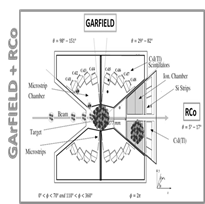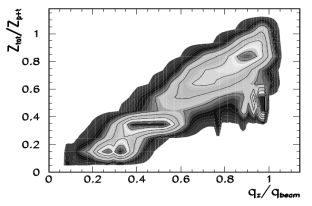INTRODUCTION
The formation of transient excited nuclear systems, up to the continuum, can be obtained using heavy ion nuclear collisions, which are produced at excitation energies well above the particle emission threshold and, some time, even above the much larger emission threshold of fragments. Therefore, important studies can be performed aiming at studying the nuclear matter in extreme conditions of density, temperature, angular momentum and isospin. However, since normally very short interaction times are involved, such systems can be studied only through their decay products and their correlations. These experiments are very challenging both from the point of view of the detection systems and from the complex analysis, made on an event-by-event basis, which have to deal with a quite large number of decay products in the exit channels.
In particular, the present study is mainly dedicated to the decay of light composed systems. The description of an excited light nucleus is a matter of debate since it is not clear whether a pure statistical decay framework can be used to describe such small systems. The study of fusion reaction which bring to light excited systems is, moreover, interesting since it is the only mode to access the level density above the particle threshold: exclusive measurements may give new and interesting information on this subject and on the possible coupling to the continuum. Moreover, it is known that light nuclei may present pronounced cluster structures, which may influence even the dynamic of the reactions, changing the relative competition yield.
Last, but not less important, is the fact that light nuclei are those fragments produced in multi-fragmentation phenomena: a specific knowledge of their decay may permit the back-reconstruction of the primary partitions in the freeze out volume, from which one can obtain important information on the Nuclear Equation of State, especially on the Symmetry Energy term.
In order to detect the most complete event as possible, very complex apparatus are used, based on a ~4
In particular, the GARFIELD - RComultidetector [6] has been used to perform the experiments hereafter described.
Moreover, to get information on both the decaying sources and the competing mechanisms, it is necessary to perform complex analysis, looking for exclusive observables, which are able to evidence signatures of the different involved processes, when compared to specific theoretical models.
In this contribution, some results obtained in different measurements performed at the TANDEM XTU accelerator of the Legnaro National Laboratory of INFN, will be presented.
MATERIALS AND METHODS
The experiments have been performed at the Legnaro National Laboratory, where beams of 12C ,14Ni , 16,18O and 19F have been used in two different campaigns onto several thin targets, in order to study fusion-evaporation mechanisms and their competition with fast emission processes. The experimental apparatus used in both experimental measurements was the GARFIELD+RCo 4
Major details on the energy and angular resolutions and of the overall performances are reported in ref. [7]. A sketch of the layout of the apparatus is shown in Fig. 1.
In order to carry out a dedicated analysis, event selection must be performed. Mainly two kind of events have been selected in the following analysis: i) central collisions asking for the detection of a fragment (Evaporation Residue) in the forward direction, and,in coincidence, one or more light charged particles detected in the whole apparatus; ii) peripheral collisions, mainly corresponding to the inelastic reactions in which the projectile is excited and can decay through a multiple
RESULTS & DISCUSSION
The 12C+12C and 14N+10B cases
The 12C+12Creaction at 95 MeV have been studied for the formation of the excited compound nucleus 24Mg. A dedicated Hauser Feshbach model (HFl)have been developed introducing in the code all the level from NUDAT database [1,8].
Comparing the experimental data to HFl statistical model calculation, some particular features have been observed: in particular an underestimation of the code of yield of the Z=4 and Z=6 fragments together with an underestimation of the yields in the 2
Moreover, a difference in the energy spectra of
The Q-valuedistributions, for specific decay channels, have been reconstructed and compared to model predictions to better study the observed discrepancies. It was observed, as an example, that in the O +2
Moreover, discrepancies with respect to model predictions are also observed when looking to the shape of the exclusive
To better disentangle if the differences are related to entrance channel effects or to different issues related either to non-statistical behaviors and or to clustering memories, the comparison with a different entrance channel have been performed and, in particular, the 14N+10B reaction was studied. A common pattern in the Q-value distributions was observed in both cases, even if some differences were observed in the relative yield of the less dissipative versus the more dissipative (Q>/Q<)populations. Entrance channel effects have been confirmed, with a partial contribution of direct reactions in the C+C case. However, still differences remain with respect to a pure statistical behavior and, in particular, exit channels with Carbon, Oxygen and Neon residues show in both cases a preferential
The 16O+30Si, 18O+28Si and 19F+27Al cases
A comparative study of the four reactions 16O+30Si,18O+28Si and 19F+27Al at 7 MeV/n and 16O+30Si at 8 MeV/n has been done, in order to continue an extensive program on the competition between complete fusion and fast processes and its possible relation with cluster structure effects of the colliding partners. The idea was to study these systems, firstly, at the onset of the fast emission and then to perform a following study of the same systems at higher bombarding energies, where the pre-equilibrium part is well assessed. The first measurement is object of this paper.
Cluster emission from hot composite systems has been a matter of debate for many years, since it is not yet known if their presence is due to a pre-formation either in the colliding partners or in the compound nucleus it-self or they are formed in the dynamical path of the collision. One possibility to evidence this phenomenon is to observe the de-excitation of nuclear systems formed with different entrance channels, especially observing the competition between pre-equilibrium emission of clusters with respect to statistical emission and analyze all possible differences through correlation studies.
For central impact parameters, and in case of complete fusion, the studied reactions all lead to the same compound nucleus 46Ti*, even if with slightly different excitation energies. The main characteristics of the studied reactions are reported in Table 1.
Table 1 Main characteristics of the studied reactions
| Entrance Channel Parameters | Compound Nucleus properties | ||||||
|---|---|---|---|---|---|---|---|
| Projectile | Elab(MeV) | Target | Entrance Channel Mass asymmetry | CN | Fusion Cross section (mb) | CN - Excitation Energy (MeV) | CN- Lab Velocity |
| 16O | 7.0 | 30Si | 0.30 | 46Ti | 1081 | 88.0 | 1.28 |
| 16O | 8.0 | 30Si | 0.30 | 46Ti | 1070 | 98.4 | 1.37 |
| 18O | 7.0 | 28Si | 0.22 | 46Ti | 1110 | 98.5 | 1.44 |
| 19F | 7.0 | 27Al | 0.17 | 46Ti | 1100 | 103.5 | 1.52 |
One of the main problems observed in the measurements was related to a high level of contamination of O in the Si target and a smaller one in the Al target. Dedicated measurements were performed on the targets themselves with RBS technique [10] in order to define quantitatively the amount of contaminants and it resulted a ratio of ~1 of O with respect to both 30Si and 28Si targets, while of ~ 0.3 for the 27Al one. The effects of such contamination on experimental spectra can be observed looking to the energy spectra previously published, where almost no visible evidence is observed in the proton spectra, while the
In order to avoid contaminated events, a strict selection was performed on the data to be further analyzed, asking for an almost complete event reconstruction: in particular a Ztot/Zp+Zt>16 and a 0.5<qz/qbeam<1.2 was required as it is shown in Fig. 3.
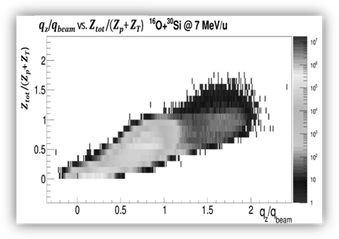
Figure 3 16O+30Si at 111 MeV: distribution of the total detected charge versus the total detected longitudinal momentum. Selections on Ztot/Zp+Zt>16 and 0.5<qz/qbeam>1.2 have been performed to avoid target contamination and random coincidences.
Moreover, in these selected events, to define central collisions the detection of an evaporation residue (ER) in the forward direction (RCo) in coincidence with one or more light charged particles in the remaining apparatus has been requested. The correlation between the detected charge and the energy in the laboratory frame is shown in Fig. 4 for the total events (left panel) and for the selected central events (right panel) for the reaction 16O+30Si at 7 MeV/n. In the right panel it is evident the region of contamination due to the presence of O in the target, close to the region of 8<Z<13.
The energy distributions of the light charged particles in coincidence with a residue have been studied and compared to those obtained through model predictions. In particular, the statistical code GEMINI++ [11], which is based on a complete fusion hypothesis, has been used.
Moreover, dynamical codes, followed by an after-burner have been also considered.
In particular, the comparison to prediction from two dynamical codes, based on very different assumptions have been done: the TWINGO code [12], based on Stochastic Mean Field approximation, where each nucleon is described through a certain number of test particles (100 in our case) and the Antisymmetrized Molecular Dynamics (AMD) code [13], which follows the time evolution of single particle wave functions described by Gaussian wave packets.
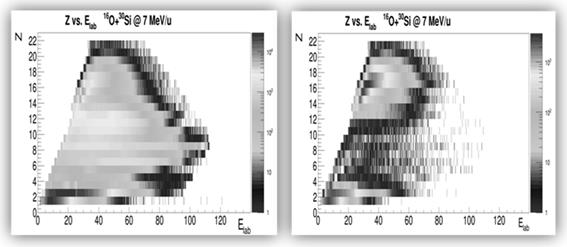
Figure 4 16O+30Si at 111 MeV: Correlation between the detected charge Z and the Energy for total events (left panel) in which the contamination from the reaction on O is evident (mainly 8<Z>13) and for selected central events (right panel) with the constrain on Ztot/Zp+Zt>0.7 and qz/qbeam<1.2 (almost complete events).
In the last one, particle-particle correlations are considered and cluster structure of the interacting partners can be taken into account.
From preliminary results, almost all the cross section seem to be well described in term of complete fusion, since the Gemini prediction well describe all the light charged particle spectra.
Only at the very forward angles, in fact, a small discrepancy can be observed when looking to
However looking at more exclusive observables, one can observe interesting differences between the studied reactions, which cannot be taken into account simply by the statistical code GEMINI++.
These discrepancies, that have been, preliminarily, observed in the multiplicity distributions (see Fig. 6) and in the reconstructed Q-values distributions in selected multiple
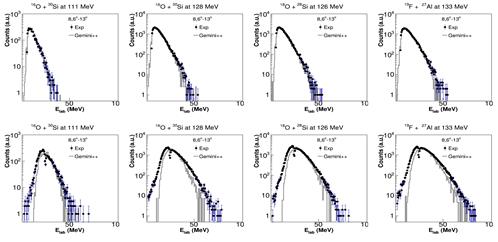
Figure 5 Proton and
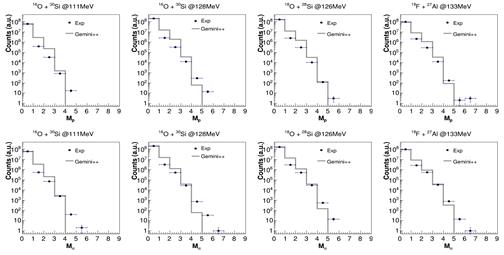
Figure 6 Experimental proton (upper panel) and
As it can be observed proton spectra are well described by GEMINI++ for the four reactions, while only the lower energy in the case of 16O+30Si is well accounted for in the case of
CONCLUSIONS
We have presented some results related to the24Mg* decay: the decay branching ratios seems to depend on the number of
In connection to the light system decay modes, but also related to the problems of the competition between thermal emission and fast emission processes, the pre-equilibrium and clustering effects on dynamics is being studied through four different entrance channels: 16O+30Si,18O+28Si and 19F+27Al at 7 MeV/n and 16O+30Si at 8 MeV/n. Studying the decay of 46Ti*, the compound nucleus formed for all the reactions in case of complete fusion, from the preliminary data analysis we can remark that the major part of the observed light charged particle energy spectra are compatible with a standard statistical decay, except for a small pre-equilibrium effect in the













